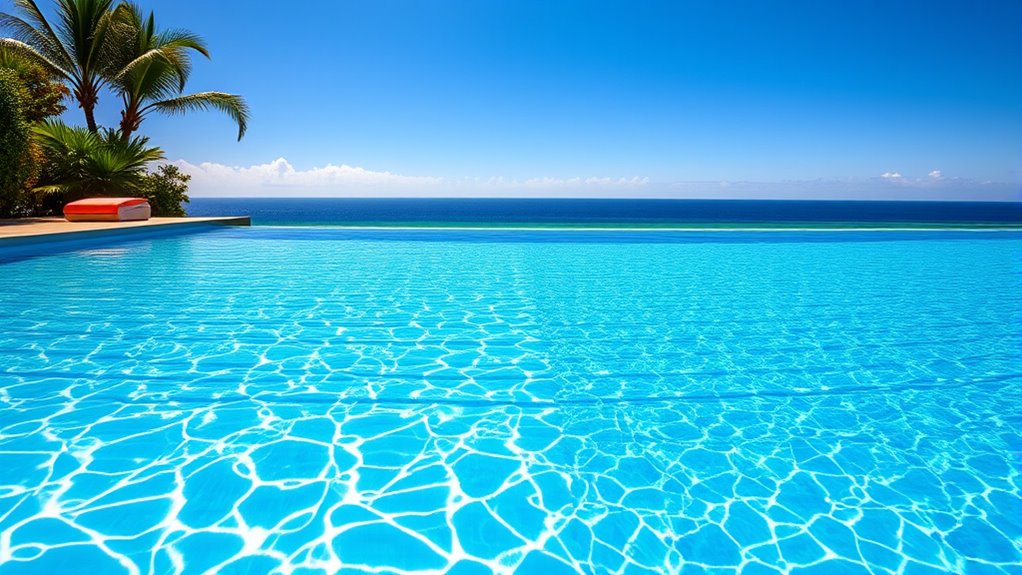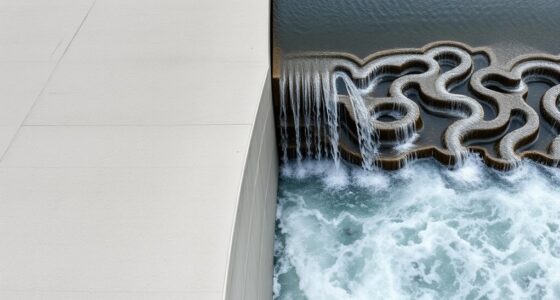Choosing between saltwater and chlorine for your infinity pool depends on your priorities. Saltwater systems generate chlorine gradually, making the water softer, gentler on skin and eyes, and easier to maintain, but they cost more upfront and need corrosion-resistant materials. Chlorine pools are simpler to install and cheaper initially but require more ongoing chemical treatments. To find the best fit for your pool’s beauty, comfort, and long-term upkeep, explore the details ahead.
Key Takeaways
- Saltwater pools offer gentler skin and eye comfort with lower chlorine levels, enhancing overall swimming experience.
- They require higher initial setup costs but lower ongoing chemical expenses compared to traditional chlorine pools.
- Saltwater systems produce chlorine gradually, reducing harshness and maintaining consistent sanitizer levels.
- Corrosion and material compatibility are concerns in saltwater pools, potentially increasing long-term maintenance costs.
- Chlorine pools are simpler to install and maintain but involve higher chemical purchases and potential irritation.
Understanding the Basics of Saltwater and Chlorine Systems
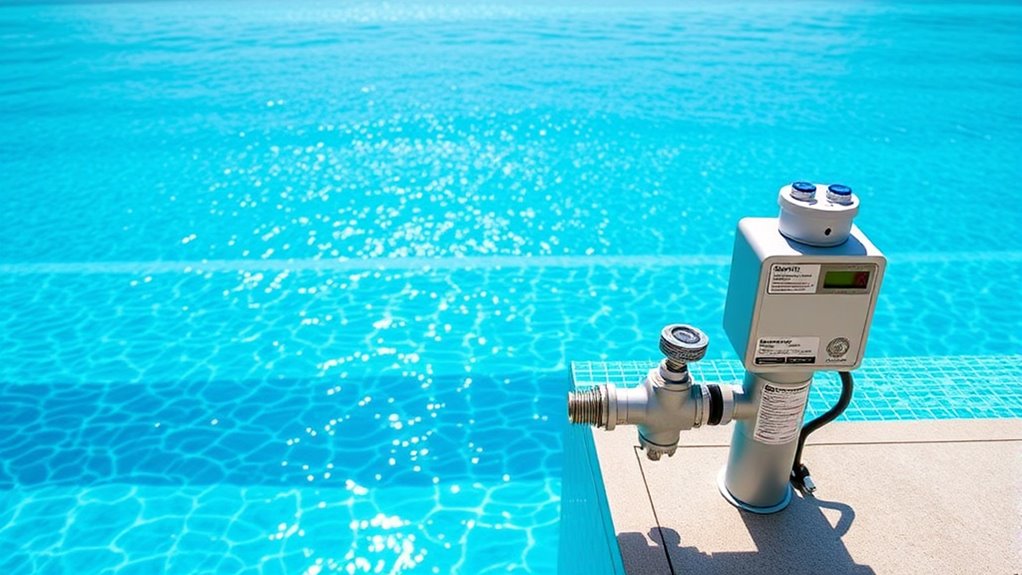
While both saltwater and chlorine pools serve the same purpose—keeping your pool clean and safe—they do so through different mechanisms. In a chlorine pool, you add chlorine manually or through automated systems to disinfect the water. Chlorine kills bacteria and algae directly, maintaining water clarity. Saltwater pools, on the other hand, use a salt chlorine generator that converts salt into chlorine through electrolysis. This process produces chlorine continuously, making maintenance more automated. Saltwater pools tend to feel softer and less harsh on the skin and eyes because of the lower chlorine levels. Additionally, maintenance routines differ between the two systems, with saltwater pools often needing fewer chemical additions once set up. Understanding these basics helps you decide which system aligns best with your pool maintenance preferences.
Comparing Maintenance and Operating Costs

When evaluating the maintenance and operating costs of saltwater versus chlorine pools, it’s important to contemplate how each system impacts your budget over time. Saltwater pools typically have higher upfront costs due to equipment, but lower ongoing expenses. Chlorine pools usually cost less initially but require regular chemical purchases. Maintenance efforts differ as well: saltwater systems need less chemical balancing, reducing labor, while chlorine pools demand frequent chemical adjustments and testing. Additionally, understanding total‑cost clarity can help you make an informed decision that aligns with your financial priorities. Here’s a quick comparison:
| Cost Aspect | Saltwater Pool | Chlorine Pool |
|---|---|---|
| Initial Investment | Higher (equipment & setup) | Lower |
| Ongoing Expenses | Lower (fewer chemicals) | Higher (chemicals & testing) |
| Maintenance Effort | Less frequent, simpler | More frequent, detailed |
Evaluating Skin and Eye Comfort

Saltwater pools are often praised for their gentler effect on skin and eyes compared to traditional chlorine pools. You’ll likely notice less irritation during and after swimming, especially if you have sensitive skin or eyes. The lower levels of chloramines, which cause redness and discomfort, make your swim more comfortable. Saltwater systems produce chlorine more gradually, maintaining a steadier, milder sanitizer level. This reduces the harsh, drying effects often associated with traditional chlorine. Some swimmers find they experience fewer skin dryness and eye irritation, making saltwater pools more enjoyable for extended use. Additionally, HEPA filtration in air purifiers demonstrates how effective filtration can improve overall air quality, highlighting the benefits of consistent, gentle sanitization. Overall, saltwater pools tend to offer a more comfortable swimming environment, especially for frequent or long-duration swims.
Assessing Environmental Impact and Sustainability
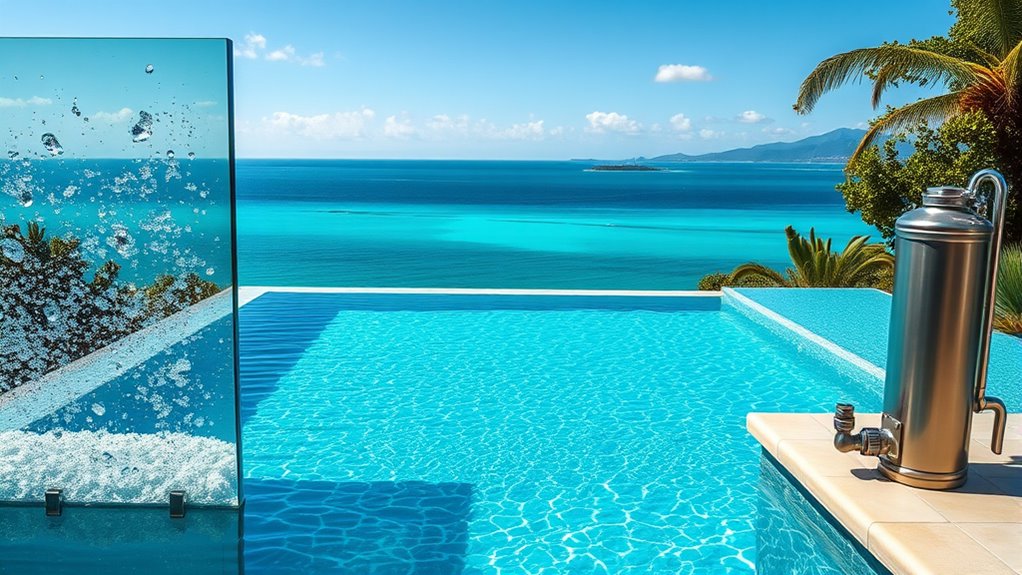
When comparing saltwater and chlorine pools, it’s important to take into account their environmental footprints and how sustainable they are over time. You’ll want to look at eco-friendliness and how much effort each method requires for maintenance. Understanding these factors helps you choose a pool system that’s better for the environment and easier to care for. Proper venting requirements during installation can also influence the overall safety and environmental impact of the pool system.
Eco-Friendliness Comparison
While both saltwater and chlorine pools have their environmental impacts, saltwater systems generally offer a more sustainable option due to their lower chemical consumption and reduced chemical runoff. Saltwater pools use salt to generate chlorine, which means fewer chemicals are added manually. This reduces chemical production, packaging waste, and potential runoff into surrounding ecosystems. To compare, consider the following:
| Aspect | Saltwater Pool | Chlorine Pool | Environmental Impact |
|---|---|---|---|
| Chemical Use | Generates chlorine from salt | Requires adding chlorine manually | Lower in saltwater systems |
| Chemical Waste | Minimal, from salt conversion | Higher, from frequent chemical additions | Less runoff with saltwater systems |
| Energy Consumption | Moderate (electrolysis process) | Varies, often higher | Slightly more eco-friendly overall |
Saltwater pools are generally better for the environment, but both choices impact sustainability. Additionally, advancements in sustainable pool technologies continue to improve eco-friendliness across both options.
Maintenance Sustainability Factors
Maintaining an infinity pool sustainably involves evaluating the environmental impacts of the systems and practices you choose. Saltwater systems typically require less chemical maintenance, reducing the need for harsh chemicals that can harm ecosystems. They also often use fewer energy-consuming devices, lowering your carbon footprint. In contrast, chlorine pools depend on regular chemical additions and sometimes more intensive filtration, which can consume more resources over time. Consider the longevity and resource efficiency of your equipment—long-lasting, energy-efficient pumps and salt generators contribute to sustainability. Proper maintenance, like regular cleaning and monitoring water quality, minimizes chemical waste and conserves water. Additionally, selecting energy-efficient filtration systems can significantly reduce overall energy consumption. Overall, choosing systems and practices that optimize efficiency and reduce chemical use supports a greener, more sustainable infinity pool.
Examining Longevity and Material Compatibility
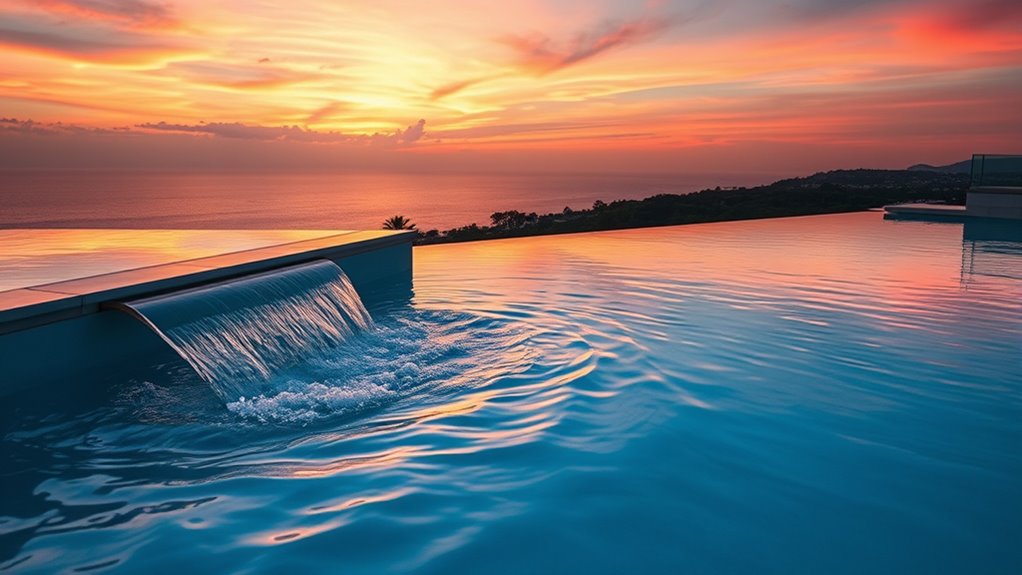
Saltwater and chlorine systems each have distinct impacts on the longevity and material compatibility of infinity pools. Saltwater pools tend to be gentler on pool components, reducing corrosion and wear over time, which can extend the lifespan of your pool’s fixtures and surfaces. However, the salt can still cause damage if materials aren’t specifically rated for it, especially in older or incompatible equipment. Using corrosion-resistant materials and implementing proper maintenance practices can help mitigate these effects. Chlorine pools, on the other hand, often experience faster degradation of certain materials like seals, liners, and metal parts due to the chemical’s aggressive nature. Choosing corrosion-resistant materials and regular maintenance can mitigate these effects. Overall, your pool’s longevity depends on proper material selection and consistent upkeep, regardless of whether you opt for saltwater or chlorine.
Analyzing Installation and Setup Requirements
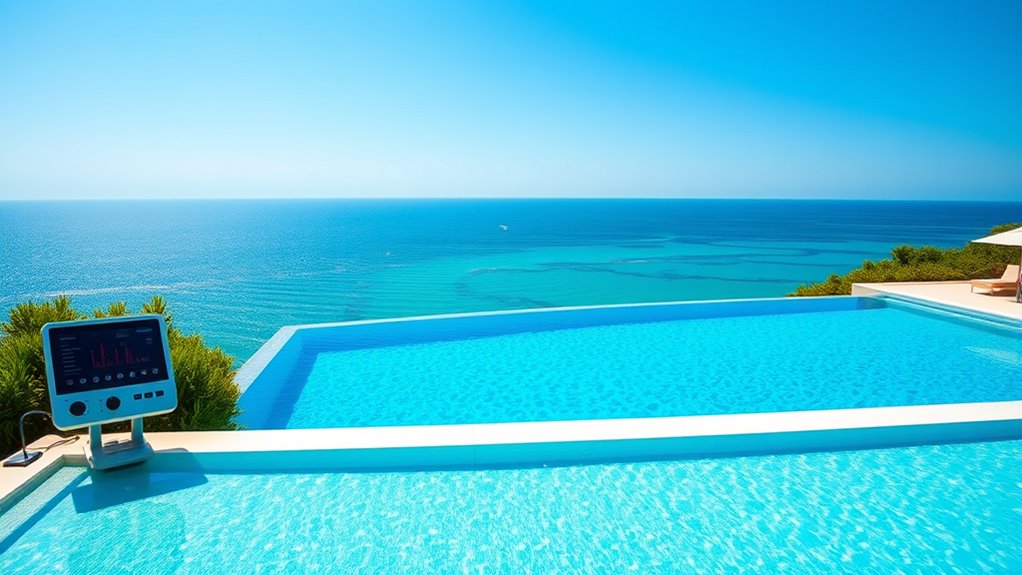
Setting up your infinity pool requires careful attention to installation complexity and equipment needs. Saltwater systems often need specialized components, while chlorine setups may be more straightforward. Understanding these requirements helps you plan effectively and avoid surprises during installation. Additionally, color accuracy in water treatment and lighting can significantly influence the visual appeal of your pool.
Installation Complexity
Installing an infinity pool requires careful planning and execution, as the setup process varies markedly between saltwater and chlorine systems. Saltwater pools typically demand a more complex installation due to their specialized equipment, like salt chlorinators, which need proper placement and electrical connections. You’ll also need to guarantee your pool’s construction can accommodate the salt system without corrosion issues. Chlorine pools, on the other hand, usually involve simpler setup steps, such as installing a standard pump, filter, and chlorinator. While both systems require a solid foundation and plumbing, saltwater pools often involve additional considerations like corrosion-resistant materials and precise electrical work. Overall, saltwater pools tend to be more intricate to install, requiring extra attention to equipment placement and material choices. Additionally, regulatory compliance for saltwater systems may involve specific installation standards to ensure safety and performance.
Equipment Setup Needs
Because the equipment needs for saltwater and chlorine pools differ considerably, your setup process must be tailored accordingly. Saltwater pools require specialized components like a salt chlorinator, which converts salt into chlorine, while chlorine pools need a chlorinator or feeder for chemical addition. Here are key setup considerations:
- Saltwater Pool: Install a salt chlorinator cell compatible with your pool size.
- Chlorine Pool: Set up a chlorinator or chemical feeder to maintain chlorine levels.
- Plumbing: Ensure proper piping for saltwater circulation versus chemical feed lines.
- Electrical Connections: Provide dedicated power for the chlorinator unit in both setups.
- Passive voice detection Proper installation guarantees efficient operation and longevity, so follow manufacturer instructions carefully for each system.
Making the Choice: Factors to Consider for Your Infinity Pool
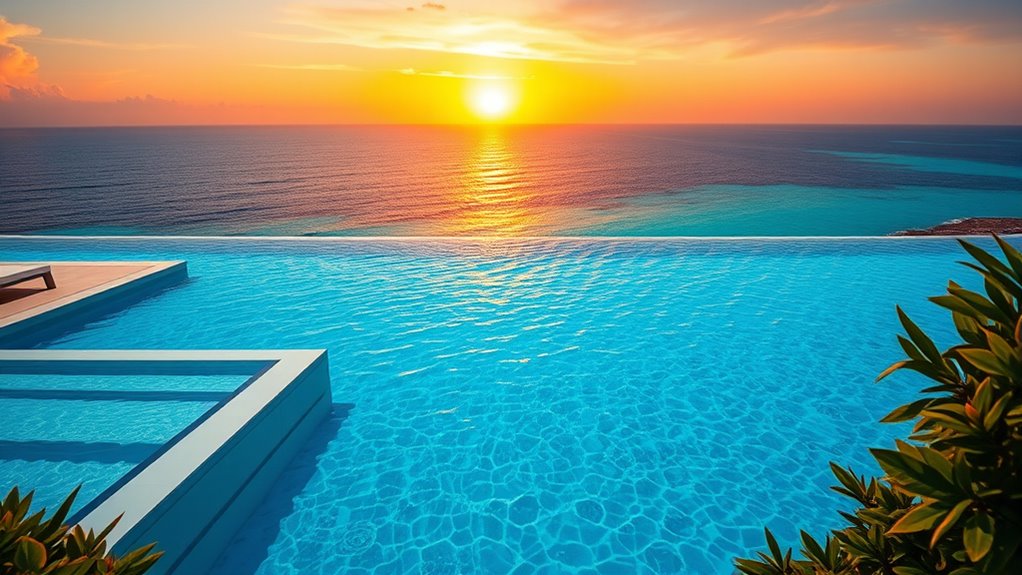
When choosing between saltwater and chlorine for your infinity pool, it’s important to take into account several key factors that will impact maintenance, comfort, and long-term costs. First, consider your budget: salt systems often have higher upfront costs but lower ongoing chemical expenses, while chlorine pools typically cost less initially but require more frequent chemical additions. Think about your comfort preferences: saltwater pools are gentler on the skin and eyes, making them more pleasant to swim in. Maintenance-wise, salt systems tend to be easier since they generate chlorine automatically, but they may need occasional equipment repairs. Finally, evaluate your willingness to handle potential equipment corrosion and your long-term plans for the pool. Weighing these factors helps ensure you choose an option that fits your lifestyle and budget.
Frequently Asked Questions
How Do Saltwater and Chlorine Pools Affect Pool Water Chemistry Long-Term?
Saltwater pools tend to maintain more stable water chemistry over time, reducing the need for frequent adjustments, while chlorine pools require regular testing and balancing to keep pH, alkalinity, and sanitizer levels steady. Saltwater systems produce fewer chloramines, leading to less irritation and clearer water. However, both systems can cause equipment wear and corrosion if not properly maintained, so consistent monitoring is essential for long-term water quality.
Are There Health Risks Associated With Saltwater or Chlorine in Infinity Pools?
You might worry about health risks from saltwater or chlorine in infinity pools, but generally, they’re safe when properly maintained. Chlorine can cause skin and eye irritation if levels are too high, while saltwater pools tend to be gentler on your skin and eyes. Regular testing and balancing of chemicals reduce risks, so you can enjoy your infinity pool without concern. Just guarantee proper maintenance and hygiene practices.
Can Saltwater Systems Be Used in Salt-Sensitive Environments or Regions?
Sure, saltwater systems can be used in salt-sensitive environments, but don’t be surprised if your plants or nearby soil start showing signs of salt stress. You might think it’s a smart choice, only to realize the irony when salt begins to seep into your landscape or groundwater. If you’re in a delicate ecosystem, it’s better to explore alternative sanitation options to avoid unintended damage.
What Are the Safety Considerations for Children and Pets Around Each System?
You should always supervise children and pets around pool systems, whether saltwater or chlorine. Chlorine pools can cause skin and eye irritation if not properly maintained, while saltwater pools have lower chlorine levels but still pose risks if ingested or if skin sensitivities exist. Keep the pool area secure with fencing, enforce safety rules, and regularly check chemical levels to guarantee a safe environment for everyone.
How Do Seasonal Climate Changes Impact Saltwater and Chlorine Pool Maintenance?
Seasonal climate changes affect your pool maintenance considerably. Cold weather can slow down chemical reactions, making it harder to keep your saltwater or chlorine pool balanced. In winter, you might need to dilute or add chemicals less frequently. Freezing temperatures can damage equipment, so you should winterize your pool properly. During summer, increased temperatures accelerate evaporation and chemical demand, requiring more frequent adjustments to keep your pool safe and clean.
Conclusion
So, whether you choose saltwater or chlorine, remember that both promise crystal-clear waters—but only one truly offers “luxury” at a higher cost, and the other claims to be gentler on your skin. Ironically, the “easier” option might mean more maintenance in disguise, while the “cheaper” choice could end up costing more in the long run. Ultimately, your perfect infinity pool depends on what you value most—luxury, savings, or just the illusion of simplicity.

